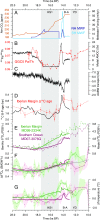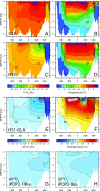Asynchronous warming and δ18O evolution of deep Atlantic water masses during the last deglaciation
- PMID: 28973944
- PMCID: PMC5651742
- DOI: 10.1073/pnas.1704512114
Asynchronous warming and δ18O evolution of deep Atlantic water masses during the last deglaciation
Abstract
The large-scale reorganization of deep ocean circulation in the Atlantic involving changes in North Atlantic Deep Water (NADW) and Antarctic Bottom Water (AABW) played a critical role in regulating hemispheric and global climate during the last deglaciation. However, changes in the relative contributions of NADW and AABW and their properties are poorly constrained by marine records, including δ18O of benthic foraminiferal calcite (δ18Oc). Here, we use an isotope-enabled ocean general circulation model with realistic geometry and forcing conditions to simulate the deglacial water mass and δ18O evolution. Model results suggest that, in response to North Atlantic freshwater forcing during the early phase of the last deglaciation, NADW nearly collapses, while AABW mildly weakens. Rather than reflecting changes in NADW or AABW properties caused by freshwater input as suggested previously, the observed phasing difference of deep δ18Oc likely reflects early warming of the deep northern North Atlantic by ∼1.4 °C, while deep Southern Ocean temperature remains largely unchanged. We propose a thermodynamic mechanism to explain the early warming in the North Atlantic, featuring a strong middepth warming and enhanced downward heat flux via vertical mixing. Our results emphasize that the way that ocean circulation affects heat, a dynamic tracer, is considerably different from how it affects passive tracers, like δ18O, and call for caution when inferring water mass changes from δ18Oc records while assuming uniform changes in deep temperatures.
Keywords: Atlantic water masses; deep ocean warming; last deglaciation; oxygen isotopes.
Conflict of interest statement
The authors declare no conflict of interest.
Figures





References
-
- Broecker WS. Paleocean circulation during the last deglaciation: A bipolar seesaw? Paleoceanography. 1998;13:119–121.
-
- Roberts NL, Piotrowski AM, McManus JF, Keigwin LD. Synchronous deglacial overturning and water mass source changes. Science. 2010;327:75–78. - PubMed
-
- McManus JF, Francois R, Gherardi J-M, Keigwin LD, Brown-Leger S. Collapse and rapid resumption of Atlantic meridional circulation linked to deglacial climate changes. Nature. 2004;428:834–837. - PubMed
-
- Shakun JD, et al. Global warming preceded by increasing carbon dioxide concentrations during the last deglaciation. Nature. 2012;484:49–54. - PubMed
-
- Skinner LC, Fallon S, Waelbroeck C, Michel E, Barker S. Ventilation of the deep Southern Ocean and deglacial CO2 rise. Science. 2010;328:1147–1151. - PubMed
Publication types
LinkOut - more resources
Full Text Sources
Other Literature Sources
Miscellaneous

